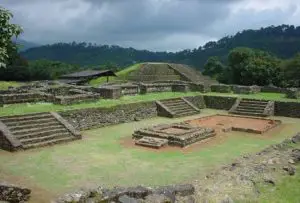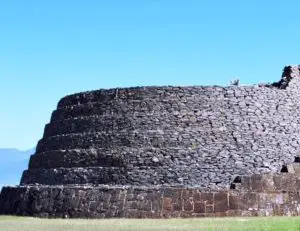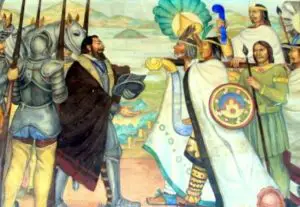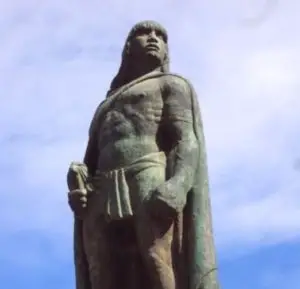Podcast: Play in new window | Download
Subscribe: Apple Podcasts | RSS
 The year was 1520. Zuanga, the sixteenth emperor or cazonci of the Tarascan Empire could barely stand, but he struggled to do so. From the royal residence on the hill called Yahuarato, he watched the sun set over Lake Pátzcuaro. He had been born on the island of Janitzio in the middle of the lake to the great Emperor Tzitzipandáquare. Under his father’s rule the Tarascans had expanded to the Pacific coast and to the east to challenge the mighty Aztec Empire. Zuanga continued his father’s plan of expansion but knew that his own days were numbered. He could barely stand to watch the sun set over the great lake because he had come down with the same mysterious illness that had been killing tens of thousands of his subjects. Like the others, the great emperor had the high fevers and the blisters and bumps covering his body. The sickness seemed to spread along with the bad news that came from the east, the stories of the strange men dressed in metal who had powerful weapons and who rode gigantic deer. The priests of his empire told Zuanga that there would be big changes in his realm over the next few years, but the emperor could never have imagined the death all around him. It seemed to have arrived on the wind. Was this the result of certain cruelties his people visited on their conquered enemies? Were the gods not pleased with his rule? Zuanga contemplated these things as he saw the sun set, wondering if this would be his last. He would never see the arrival of the strange metal men riding large deer. Emperor Zuanga would not live to see the end of 1520.
The year was 1520. Zuanga, the sixteenth emperor or cazonci of the Tarascan Empire could barely stand, but he struggled to do so. From the royal residence on the hill called Yahuarato, he watched the sun set over Lake Pátzcuaro. He had been born on the island of Janitzio in the middle of the lake to the great Emperor Tzitzipandáquare. Under his father’s rule the Tarascans had expanded to the Pacific coast and to the east to challenge the mighty Aztec Empire. Zuanga continued his father’s plan of expansion but knew that his own days were numbered. He could barely stand to watch the sun set over the great lake because he had come down with the same mysterious illness that had been killing tens of thousands of his subjects. Like the others, the great emperor had the high fevers and the blisters and bumps covering his body. The sickness seemed to spread along with the bad news that came from the east, the stories of the strange men dressed in metal who had powerful weapons and who rode gigantic deer. The priests of his empire told Zuanga that there would be big changes in his realm over the next few years, but the emperor could never have imagined the death all around him. It seemed to have arrived on the wind. Was this the result of certain cruelties his people visited on their conquered enemies? Were the gods not pleased with his rule? Zuanga contemplated these things as he saw the sun set, wondering if this would be his last. He would never see the arrival of the strange metal men riding large deer. Emperor Zuanga would not live to see the end of 1520.
 The Tarascans, also known as the Purépecha, remain a mystery to this day. The modern-day Tarascans still live in their ancestral homeland, territories comprising most of the Mexican state of Michoacán and smaller areas of surrounding states. Anthropologists puzzle over the origins of this seemingly unique people, as the Tarascans are unlike any other group in Mesoamerica. Their language is a linguistic isolate in Mexico and unrelated to any local languages. Some linguists have linked the Purépecha language to the Zuni language of Arizona and New Mexico, thousands of miles to the north, while others see similarities to Quechua, the language of the Inca of South America. The Tarascan building style suggests a link with the Inca, but those who propose a South American connection do not know if the Tarascans were once refugees or part of some ancient empire expansion that stretched north along the coast of the Americas. Archaeologists believe that the Tarascans emerged as the dominant culture in the Lake Pátzcuaro region around 1000 AD. Their political infrastructure coalesced over the next 300 years. According to Tarascan oral tradition, sometime around the year 1300 a visionary leader named Taríacuri decided to gather the Tarascan communities around Lake Pátzcuaro into one strong state and started conquering neighboring cities and towns. He put his sons and other relatives in charge of the newly subdued territories. By around 1350, the Tarascans had established their future imperial capital of Tzintzuntzan – “The Place of the Hummingbirds,” in English – on the eastern shore of the lake on a strategic hill. By the middle of the 1400s Tzintzuntzan had become the administrative capital of the new empire that dominated the west-central part of ancient Mexico and threatened the Aztec hold over central Mexico.
The Tarascans, also known as the Purépecha, remain a mystery to this day. The modern-day Tarascans still live in their ancestral homeland, territories comprising most of the Mexican state of Michoacán and smaller areas of surrounding states. Anthropologists puzzle over the origins of this seemingly unique people, as the Tarascans are unlike any other group in Mesoamerica. Their language is a linguistic isolate in Mexico and unrelated to any local languages. Some linguists have linked the Purépecha language to the Zuni language of Arizona and New Mexico, thousands of miles to the north, while others see similarities to Quechua, the language of the Inca of South America. The Tarascan building style suggests a link with the Inca, but those who propose a South American connection do not know if the Tarascans were once refugees or part of some ancient empire expansion that stretched north along the coast of the Americas. Archaeologists believe that the Tarascans emerged as the dominant culture in the Lake Pátzcuaro region around 1000 AD. Their political infrastructure coalesced over the next 300 years. According to Tarascan oral tradition, sometime around the year 1300 a visionary leader named Taríacuri decided to gather the Tarascan communities around Lake Pátzcuaro into one strong state and started conquering neighboring cities and towns. He put his sons and other relatives in charge of the newly subdued territories. By around 1350, the Tarascans had established their future imperial capital of Tzintzuntzan – “The Place of the Hummingbirds,” in English – on the eastern shore of the lake on a strategic hill. By the middle of the 1400s Tzintzuntzan had become the administrative capital of the new empire that dominated the west-central part of ancient Mexico and threatened the Aztec hold over central Mexico.
 Tzintzuntzan is unlike any other city in ancient Mexico. Long neglected by archaeologists who took very little interest in the ancient Tarascans, Tzintzuntzan features unique monumental architecture. Five large yácatas, or round pyramidal structures, make up the larger part of the civic-ceremonial center of the city. Built on a platform cut into a hill with sweeping views of Lake Pátzcuaro, the yácata complex dominated the area of Tzintzuntzan called the Taríaran in the Purépecha language, which loosely translates to English as, “The House of the Wind.” Here lived the nobles and priests and anyone else who was important in the Tarascan Empire. It was also the site of the temples to the main Tarascan god Curicaueri. Much like the “fire temples” of the Middle Eastern Zoroastrian religion, the temples to the god Curicaueri, had ceremonial fires burning in them from time immemorial and served as a tangible link to the past. In the Tarascan fire temples priests made sacrifices to the gods, usually prisoners of war. The sacrificial victims served as holy messengers and played an important role in the structure of Tarascan religion. As found in other archaeological sites, the Tzintzuntzan yácatas were built on top of older structures, smaller pyramid-like buildings. In the northern part of the “House of the Wind” civic-ceremonial area stood the royal palace surrounded by houses of minor nobles and residences for the important members of the priestly class. Tzintzuntzan contained 40 neighborhood divisions and in the early 1500s the city most likely had a population of between 25,000 and 30,000 people. Like many imperial capitals, Tzintzuntzan had residents from many different ethnicities and cultural groups who came from throughout the empire to live and work in the city. As the capital, Tzintzuntzan was a center of
Tzintzuntzan is unlike any other city in ancient Mexico. Long neglected by archaeologists who took very little interest in the ancient Tarascans, Tzintzuntzan features unique monumental architecture. Five large yácatas, or round pyramidal structures, make up the larger part of the civic-ceremonial center of the city. Built on a platform cut into a hill with sweeping views of Lake Pátzcuaro, the yácata complex dominated the area of Tzintzuntzan called the Taríaran in the Purépecha language, which loosely translates to English as, “The House of the Wind.” Here lived the nobles and priests and anyone else who was important in the Tarascan Empire. It was also the site of the temples to the main Tarascan god Curicaueri. Much like the “fire temples” of the Middle Eastern Zoroastrian religion, the temples to the god Curicaueri, had ceremonial fires burning in them from time immemorial and served as a tangible link to the past. In the Tarascan fire temples priests made sacrifices to the gods, usually prisoners of war. The sacrificial victims served as holy messengers and played an important role in the structure of Tarascan religion. As found in other archaeological sites, the Tzintzuntzan yácatas were built on top of older structures, smaller pyramid-like buildings. In the northern part of the “House of the Wind” civic-ceremonial area stood the royal palace surrounded by houses of minor nobles and residences for the important members of the priestly class. Tzintzuntzan contained 40 neighborhood divisions and in the early 1500s the city most likely had a population of between 25,000 and 30,000 people. Like many imperial capitals, Tzintzuntzan had residents from many different ethnicities and cultural groups who came from throughout the empire to live and work in the city. As the capital, Tzintzuntzan was a center of  trade and also served as the center of production for luxury goods and items for everyday use. The Tarascans were perhaps the most highly skilled craftsmen in all of ancient Mexico, especially in their working of metals. They were the first people to use gold and had a special gold plating technique not found anywhere else. As the only ancient Mexican people to have used bronze, at the time of European contact they were the only Mesoamerican civilization that had officially entered the Bronze Age. First and foremost, though, the city of Tzintzuntzan served as the administrative capital of the ever-growing Tarascan state. By the early 1500s the empire encompassed over 25,000 square miles and ruled over various ethnic groups and communities from the Pacific Coast to the central lake district of Mexico. Of all the ancient civilizations in Mexico, the Tarascans excelled the most in the art of bureaucracy. Their fine-tuned governmental machine followed specific rules when it came to their newly conquered lands. In some cases, newly conquered peoples were allowed to keep their ethnic identities and some of their religious and political institutions as long as they remained subject to the Empire. Sometimes entire villages of conquered people were relocated and moved to other regions, as if to “blend” or “fold” the new people into their new nation. Some captives in wars of conquest were made slaves and transported back to the Tarascan capital or to other settlements around Lake Pátzcuaro to serve in the households of Tarascan noble families. Those territories on the fringes of Tarascan Empire received support from the core. Unlike the Aztec Empire in which everything flowed to their capital, the Tarascan rulers and bureaucrats knew that they could not be a total drain on their provinces. Resources flowed outward from Tzintzuntzan as much as they flowed into the capital city. In the heartland of the Tarascan Empire, the distinct ethnic and cultural groups were encouraged to assimilate into the broader Tarascan culture, often donning the typical dress of the Tarascans and adopting the Purépecha language. In short, anyone could be a Tarascan and were accepted as such with assimilation. The Tarascans, unlike the Aztecs, had more deliberate and systematic ways of expanding their political sphere. The Tarascan ways of incorporating newly conquered lands led to less animosity and greater harmony within the Empire. While the Tarascans and the Aztecs often fought border wars and jockeyed to conquer territories new to them, there existed periods of détente between these two great civilizations. In one pre-Hispanic account, the Aztecs even received a delegation of Tarascan nobles to their capital at Tenochtitlan to participate in the festivities around the coronation of a new Aztec emperor. Perhaps the Aztecs were operating from the old notion of, “Keep your friends close, but your enemies closer.”
trade and also served as the center of production for luxury goods and items for everyday use. The Tarascans were perhaps the most highly skilled craftsmen in all of ancient Mexico, especially in their working of metals. They were the first people to use gold and had a special gold plating technique not found anywhere else. As the only ancient Mexican people to have used bronze, at the time of European contact they were the only Mesoamerican civilization that had officially entered the Bronze Age. First and foremost, though, the city of Tzintzuntzan served as the administrative capital of the ever-growing Tarascan state. By the early 1500s the empire encompassed over 25,000 square miles and ruled over various ethnic groups and communities from the Pacific Coast to the central lake district of Mexico. Of all the ancient civilizations in Mexico, the Tarascans excelled the most in the art of bureaucracy. Their fine-tuned governmental machine followed specific rules when it came to their newly conquered lands. In some cases, newly conquered peoples were allowed to keep their ethnic identities and some of their religious and political institutions as long as they remained subject to the Empire. Sometimes entire villages of conquered people were relocated and moved to other regions, as if to “blend” or “fold” the new people into their new nation. Some captives in wars of conquest were made slaves and transported back to the Tarascan capital or to other settlements around Lake Pátzcuaro to serve in the households of Tarascan noble families. Those territories on the fringes of Tarascan Empire received support from the core. Unlike the Aztec Empire in which everything flowed to their capital, the Tarascan rulers and bureaucrats knew that they could not be a total drain on their provinces. Resources flowed outward from Tzintzuntzan as much as they flowed into the capital city. In the heartland of the Tarascan Empire, the distinct ethnic and cultural groups were encouraged to assimilate into the broader Tarascan culture, often donning the typical dress of the Tarascans and adopting the Purépecha language. In short, anyone could be a Tarascan and were accepted as such with assimilation. The Tarascans, unlike the Aztecs, had more deliberate and systematic ways of expanding their political sphere. The Tarascan ways of incorporating newly conquered lands led to less animosity and greater harmony within the Empire. While the Tarascans and the Aztecs often fought border wars and jockeyed to conquer territories new to them, there existed periods of détente between these two great civilizations. In one pre-Hispanic account, the Aztecs even received a delegation of Tarascan nobles to their capital at Tenochtitlan to participate in the festivities around the coronation of a new Aztec emperor. Perhaps the Aztecs were operating from the old notion of, “Keep your friends close, but your enemies closer.”
 By the early fall of 1520, the great Tarascan emperor Zuanga had died of smallpox before the first European ever even set foot on his territory. The disease, together with the measles, spread rapidly throughout central and west-central Mexico along the trade routes and in concentrated centers of population. Before his death, Emperor Zuanga named his successor, Tangaxuan the Second. The new young and robust ruler had survived the waves of European epidemics and knew he had new challenges to face with a diminished population. Tangaxuan received emissaries from the Aztec capital of Tenochtitlan asking for assistance after the Spaniards outlived their welcome and their intentions of conquest became clear. The Tarascans responded by killing the Aztec ambassadors once they were satisfied that they had enough information from them. The young Tarascan emperor had a plan. He did not want Tzintzuntzan to meet the same fate as Tenochtitlan and wanted to apply some of the characteristic Tarascan diplomacy and tact in his relations with the foreigners. He sent a small gift-bearing delegation to Tenochtitlan to meet with the metal men who rode the gigantic deer to try to come to some sort of agreement of peaceful coexistence. When Spanish conquistador Hernán Cortés saw the fine gifts of gold given to him as a gesture of peace by the Tarascans, his interests of conquest suddenly turned to the west. He charged his former quartermaster whom he elevated to one of his head captains, Cristóbal de Olid, to lead the expedition to march on Tzintzuntzan to try to subjugate the Tarascans. Of course, the young Emperor Tangaxuan knew of the Spanish march and assembled his troops. It took Olid but a few days to reach the Tarascan capital. Confronted with tens of thousands of Tarascan troops, Olid must have felt overwhelmed, but that feeling turned to shock when the Tarascan emperor ordered his soldiers to lay down their arms. There would be no bloodshed in the way the Aztec capital fell. Tangaxuan submitted to Spanish authority, converted to Christianity and pledged his allegiance to the King of Spain in hopes that the Tarascan Empire would live on in a state of semi-autonomy. The emperor got his wish for a little while and continued to rule over his realm much as he did before. He continued collecting tribute from the provinces and the wheels of imperial administration turned as easily as they had in the past. In some accounts, Hernán Cortés was seen as a co-ruler of the Tarascan Empire, remotely, from Mexico City, even though he had no interest in traveling west into Tarascan territory. The autonomy eventually ended in 1529, however, when conquistador Nuño de Guzmán, head of the first Spanish Audencia, decided to investigate the affairs of the western provinces of New Spain more closely. He marched with 8,000 men into the Tarascan lands and was surprised to see the Tarascan Empire intact. Nuño de Guzmán allied himself with a local Tarascan lord named Cuinierángari and captured the Tarascan royal family. Emperor Tangaxuan the Second was accused of many transgressions against the Spanish King, including, but not limited to, plotting a rebellion, withholding tribute and heresy. The Spanish dismantled the famous Tarascan bureaucracy, destroyed many of the public works in Tzintzuntzan, and executed the emperor on February 14, 1530, thus ending one of the most magnificent but little-known civilizations of ancient Mexico.
By the early fall of 1520, the great Tarascan emperor Zuanga had died of smallpox before the first European ever even set foot on his territory. The disease, together with the measles, spread rapidly throughout central and west-central Mexico along the trade routes and in concentrated centers of population. Before his death, Emperor Zuanga named his successor, Tangaxuan the Second. The new young and robust ruler had survived the waves of European epidemics and knew he had new challenges to face with a diminished population. Tangaxuan received emissaries from the Aztec capital of Tenochtitlan asking for assistance after the Spaniards outlived their welcome and their intentions of conquest became clear. The Tarascans responded by killing the Aztec ambassadors once they were satisfied that they had enough information from them. The young Tarascan emperor had a plan. He did not want Tzintzuntzan to meet the same fate as Tenochtitlan and wanted to apply some of the characteristic Tarascan diplomacy and tact in his relations with the foreigners. He sent a small gift-bearing delegation to Tenochtitlan to meet with the metal men who rode the gigantic deer to try to come to some sort of agreement of peaceful coexistence. When Spanish conquistador Hernán Cortés saw the fine gifts of gold given to him as a gesture of peace by the Tarascans, his interests of conquest suddenly turned to the west. He charged his former quartermaster whom he elevated to one of his head captains, Cristóbal de Olid, to lead the expedition to march on Tzintzuntzan to try to subjugate the Tarascans. Of course, the young Emperor Tangaxuan knew of the Spanish march and assembled his troops. It took Olid but a few days to reach the Tarascan capital. Confronted with tens of thousands of Tarascan troops, Olid must have felt overwhelmed, but that feeling turned to shock when the Tarascan emperor ordered his soldiers to lay down their arms. There would be no bloodshed in the way the Aztec capital fell. Tangaxuan submitted to Spanish authority, converted to Christianity and pledged his allegiance to the King of Spain in hopes that the Tarascan Empire would live on in a state of semi-autonomy. The emperor got his wish for a little while and continued to rule over his realm much as he did before. He continued collecting tribute from the provinces and the wheels of imperial administration turned as easily as they had in the past. In some accounts, Hernán Cortés was seen as a co-ruler of the Tarascan Empire, remotely, from Mexico City, even though he had no interest in traveling west into Tarascan territory. The autonomy eventually ended in 1529, however, when conquistador Nuño de Guzmán, head of the first Spanish Audencia, decided to investigate the affairs of the western provinces of New Spain more closely. He marched with 8,000 men into the Tarascan lands and was surprised to see the Tarascan Empire intact. Nuño de Guzmán allied himself with a local Tarascan lord named Cuinierángari and captured the Tarascan royal family. Emperor Tangaxuan the Second was accused of many transgressions against the Spanish King, including, but not limited to, plotting a rebellion, withholding tribute and heresy. The Spanish dismantled the famous Tarascan bureaucracy, destroyed many of the public works in Tzintzuntzan, and executed the emperor on February 14, 1530, thus ending one of the most magnificent but little-known civilizations of ancient Mexico.
REFERENCES:
Coe, Michael D. Mexico: From the Olmecs to the Aztecs. New York: Thames and Hudson, 1994. Buy the book on Amazon here: https://amzn.to/3013VQm
Paredes M., Carlos. “Sistemas de intercambio en el estado tarasco: Notas para su estudio.” In Origen y Desarrollo en el Occidente del Mexico, Brigitte Boehm de Lameiras y Phil C. Weigand, coord. Pp. 295-305. Zamora, Mich.: El Colegio de Michoacán. (In Spanish)
